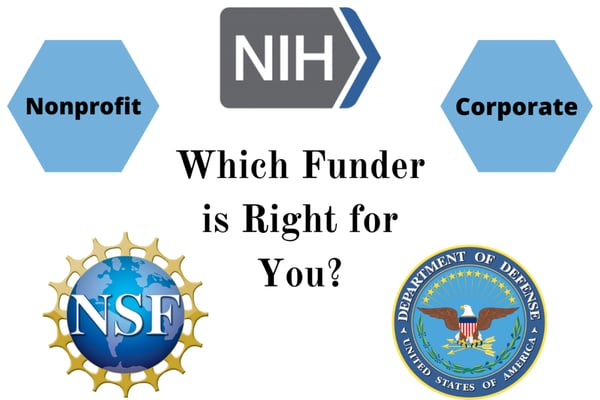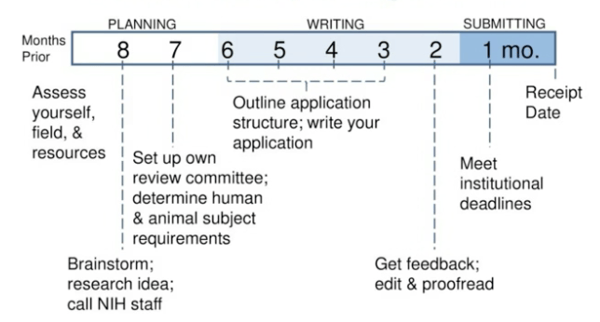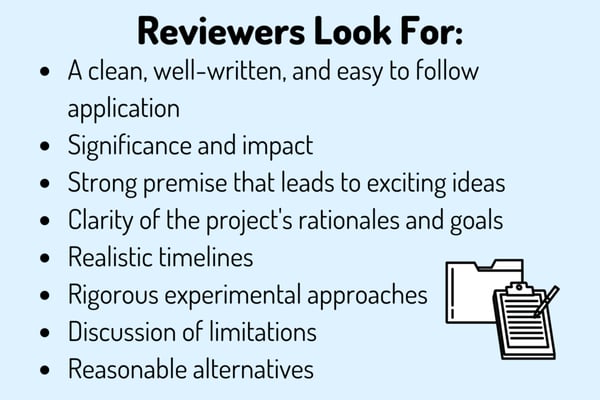9 strategies for winning grants in the U.S., especially at the NIH.
Federal grants are an invaluable tool in a startup's handbook, but applying for grant funding in the U.S. is a highly competitive and complicated journey.
Before you start writing your grant application, you must consider the barriers in place that may prevent you from creating a perfect draft the first time around.
🔬Related: What are SBIR/STTR Grants?
The National Institutes of Health (NIH) is the #1 funder of research in the United States. In 2018, the extramural research grants awarded by the NIH totaled $26 billion. Extramural grants are grants awarded for research for use outside of the NIH. This translates to 47,000 competing and non-competing awards, 12% of which were R01/R01-Equivalent. R01 awards fund projects driven by investigators over a specified period. In recent years investigators are successful in receiving R01 awards around 20% of the time. Meaning, it is likely that you will have to apply multiple times before you are granted an R01 award. Gaining the competitive edge is crucial in applying for grants at the NIH; you need to avoid common mistakes and ensure good communication in order to stand out.
Here is some common language/lingo/acronyms that will be used going forward that is helpful in understanding the NIH:
| Acronym: | Meaning: |
| FOA | Funding Opportunity Announcement |
| RFA | Request for Applications |
| RFP | Request for Proposals |
| NOFO | Notice for Funding Opportunity |
| Solicitation | Common use in Center for Disease Control (CDC) or Department of Health and Human Services (HHS) |
The first step is to find out where your application should be going. This seems obvious, but it is important to do some research to find out what the best source is for your funding. There are many different avenues that you can use to determine which funding source is the best for your project. Websites, like Grants.gov can be helpful, as well as speaking to previously successful colleagues in the field.

The funder, the mechanism, and their goals are all important when deciding where to apply. The NIH and the NSF (National Science Foundation) are the 2 main funders in the US. The NIH supports public health related research. In comparison, the NSF looks for research that furthers society and progresses science. Sometimes there is overlap between the two, and sometimes there is not. You might also consider non-profit or corporate sources for funding. The mechanism is the type of support provided; this support is either small projects called pilots, or longer projects with larger budgets. The last thing to consider is the funder’s goals. Usually funders are either focused on a specific research outlet, or on broad investigator-driven research.
🔬Related: How to Mine Federal Databases for Funding Opportunities
Once you have begun to understand where you want to apply, you also need to know what is required of you when submitting that application. Failure to comply with instructions is a common reason as to why applications are withdrawn without consideration or review. One of the most basic requirements is the formatting. FOAs will lay out things like page limits, margins, and other formatting necessities. They will also lay out their particular mission or the aspects that are considered in their review. You can see if your research is fit for a particular mission on the NIH RePORT website. Essentially, you want to make sure that all of your content matches with what the funder is looking for.
The NIH releases a table of contents within each FOA. Section IV details the ‘Application and Submission Information’. In many cases, Section IV (and other sections of the announcement) will refer you to the SF424 Application Guide. This guide contains the standard instructions from the NIH for putting applications together. But, other times the opportunity announcement will include instructions beyond that of the SF424 Guide. In that case, you will need to follow the instructions given by that specific announcement.
Planning ahead is crucial to ensure that you will not only be awarded your first grant, but also your second one (and many more after that). Creating a timeline early on will also help you ensure that there are no gaps in your funding.

The NIH provides a pre-submission timeline (above), going back about 9 months from submission. The first couple of months are more of a thinking phase, assessing data and strategizing which mission best fits your research. Pay close attention to the feedback phase, that is around 1-2 months before the due date. If you want to get feedback from an outside party, you want to make sure that you have the time to take that feedback and make changes. Asking for feedback a week before it is due will only increase stress levels and commotion before submission.
The first step after you determine which grant you would like to apply for is to start developing relationships with the funding representative, if possible. At the NIH, this is possible, and even encouraged. It is worthwhile to be in contact with the representative before you submit your application for many reasons:
🔬 Learn about: Funding Options for Biotech Startups
If you know who your audience is and what they need from you, you will be better prepared to target your grant writing toward them. Ask yourself these questions:
Your grant review panel could include all different types of people. Some will be experts and peers in the field, others will not. There may be patient representatives or community stakeholders as well. The reviewer’s job is to inform the funding agency of the strengths and weaknesses proposed to them, so the funder can make final decisions about allocating money. It might also be worthwhile to cater your applications to the funders themselves who will eventually receive your application. People from all backgrounds will be reading your application, so it should be easy to understand, but not ‘dumbed down’ for anyone.
When writing your application, make sure it comes off as a perfect match for what the funders are seeking. This is why it is important to determine the funder’s mission and whether or not it fits your project early on. One of the great ways to do this is to echo the language in the funding announcement. Using their own keywords and phrases allows them to see that your project fits what they are seeking. You want to signal to the reviewers that you are directly addressing the issues that the funder's mission tries to solve. Don’t be afraid to use exact terms from the announcement.
This also shows the readers that you did not just copy and paste your application from somewhere else. Instead, you took the time to comprehend what they are searching for.
🔬Read more about: Lean Model Canvas Approach to Developing Research Grants
Leaving gaps in your application without explanation will cause researchers to question what you are proposing. Make sure your application will address what you can improve on, and even why added funding could help you carry out their mission better. Sometimes this comes in the form of adding collaborators that could contribute to the project outside of your own field. These added collaborators can give new insight and broaden your perspectives. It is also important to show proof of what you plan to do in the future, not just stating it. Proof could mean a letter of support or a letter of collaboration. These add credibility to your ‘gaps’ that you intend to fill.
This seems obvious, but it is one of the most difficult steps. One of the most important things to consider when crafting a well-written grant application is to appeal to the reader’s ethos. Ethos is used to establish your own credibility in writing. Does the reviewer feel like they can trust you? You want to make sure that you come across as genuine and professional. Also, the reviewers at the NIH specifically will not tolerate poorly-organized applications with multiple mistakes. Interesting and exciting science does not excuse you from sloppy writing. You want to make the reviewer’s job as easy as possible!

Making your writing concise and clear at all times is very important. You don’t want the reviewers to be searching for answers in your application. Because your reviewer’s can be from many different backgrounds, you should also avoid using jargon that the average person might not immediately understand. Additionally, your proposal could be positively supplemented with graphics and schematics. While these photos will take up some writing space, it will add to your proposal and prevent it from being too wordy.
Seeking feedback far in advance of the due date is essential for a well-rounded proposal. Getting comfortable with criticism will allow you to open yourself up to new ideas. You should try to ask your colleagues for criticism about your grant proposal well before you submit, especially if you are not comfortable with your writing. These colleagues should come from different backgrounds and should have a wide array of expertise. The more, the better. It is not enough to just listen to their critiques; you also need to take them to heart and see how you can implement them in your writing. This also works the other way around. If a colleague requests your help, it is also in your best interest to give them tips on your proposal. It allows you to expand your knowledge and see how other scientific papers can be written.
The ultimate goal after putting these strategies for winning grants together is to get multiple Notices of Awards (NoAs). It might not be easy, but working on improving your skills, even after rejection, will be worth it in the end.
You probably shouldn’t think of it as ‘dumbing down’. You want to make it accessible, but don’t try to spoon feed it to them. The main thing is to try to take out as much jargon as possible. It is worthwhile to try to determine which details are critical to your proposal, and take out those that are not.
If your proposal is 5 pages, it should not have any gaps or details missing. Reviewers will not be upset about reading less. But, they might be disappointed to see you have left something out and still have room.
No, not generally. R01s at the NIH fall on a 3 cycle submission system, where different types of applications are accepted at different points throughout the year. With R01s, the standard cycle is February 5th, June 5th, and October 5th.
No, it shows that you have taken time to improve your proposal. Just make sure that it is not the exact same as what you submitted before.
Yes. An Early Stage Investigator (ESI) is someone that is within 10 years of completing their terminal degree and has not had previous funding. ESIs sometimes can get more funding or more opportunities, so it is important to take advantage of that status.
When you contact them, you should have a basic aims page ready for them. If you email them your specific aims page and ask to talk to them on the phone about your work, they will be able to give you their insight. If they don't answer, don't give up! Try contacting them again or contacting another PO.
No, reviewers take into account your experience, especially if you are an ESI. However, if you have had a faculty position for a while and don’t have any published works it may count against you.
This information comes from a talk with Sheila M. Cherry. Sheila is the founder of a company called Fresh Eyes Editing and a co-founder of Career Volt. She has worked on editing and provided feedback on scientific documents, including grant applications. The information provided below has been accumulated over the years, and the tips are generalizations for the field. They are a good guide, but can not account for all of the intricacies of grant writing.
If you want another perspective on writing grant applications, check out this ULP article on SBIR and STTR grant applications.
Be sure to subscribe to the ULP Youtube Channel to never miss another webinar, and connect with us on LinkedIn to stay in the loop!
Download The Ultimate Guide to Wet Lab Incubators in Southern California, a handbook to assist life science start-ups through the entire decision-making process to find wet lab space.
Download Now